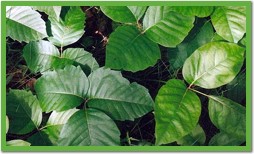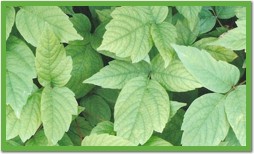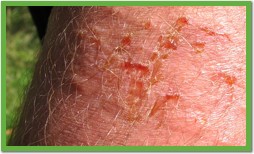
The Biology of Poison Ivy (Rhus radicans or Toxicodendron radicans)
Description
Poison Ivy is best known for its foliage ("leaves of three..."), but it's best to start with the growth form of the plant. It's actually a shrub. It has short, erect, woody stems about 10 - 30 cm high, from which emerge a few leaves each spring. The woody, aboveground stem of the plant grows only a cm or two each year. The plant has an underground, woody rootstock that creeps along, spreading to form a patch of Poison Ivy. Most patches are, in fact, one plant that is spreading underground, like quack grass in a lawn.
What we see as "leaves of three" are really single leaves divided into three leaflets. Each stem produces one to several divided leaves each year, along the short length of new stem. Each leaf has a long petiole (the stalk that attaches the leaf to the stem is the "petiole") and the leaf is divided down to the main vein, so it looks like three separate leaves. The leaflets, which may be 3 - 10 cm long, are coarsely toothed towards the end, but may be smooth near the base. The veins within each leaflet are prominent. In spring the young leaves may appear bright green and glossy, but the colour can fade and the leaf surface become waxy later in the season. The leaves actually provide lovely fall-foliage in the autumn. They may turn yellow to bright red, depending on where they are growing and the weather conditions of the year (See Fall Colours in our Fall Issue).
The flowers of Poison Ivy are in short panicles (branching spikes) that emerge from the axils of the leaves (where the leaf joins the stem). There may be 10 or more flowers per panicle. They open in late June. Each flower is about 3-5 mm across, and is greenish-yellow in colour. The size, colour and location of the flowers (under the leaves) makes them difficult to see at the best of times. If you're going to squat down to get a look at them, be careful where you squat!
The fruit of Poison Ivy, which contains its seeds, is a globular berry, greenish-white in colour, about 1/2 cm in diameter. These are ripe by early autumn, but can stay on the naked stems throughout the winter.
Look-alikes
Other plants can have "leaves of three", too, so that rule for identifying Poison Ivy is not a good one to limit yourself to. In our woodland areas there are a number of other plants that can be confused with Poison Ivy. Here's a few:
- Hog Peanut (Amphicarpa bracteata)
- This plant has leaflets that are divided into 3's. The leaves are
a lighter green than Poison Ivy and are smaller. The plant is an annual
climbing vine and is herbaceous; it doesn't have a woody base. The
smooth edges of the leaves and the lack of any woody stem distinguishes
this plant from Poison Ivy.
- Virginia Creeper (Parthenocissus quinquefolia)
- This is a woody vine with leaflets divided into 5's, but sometimes
only 3's. The leaves are about the same colour and texture as poison
ivy, but have more jagged teeth. It can form large patches on the
ground or climb onto trees or bushes, but its creeping stems are above
ground. Its berries are dark blue in colour.
- Wild Sarsaparilla (Aralia nudicaulis)
- This is a herbaceous perennial that spreads by underground rhizomes,
so it forms large patches, just like Poison Ivy. The leaves are divided
into 3 - 5 leaflets that have fine teeth along the edges. The lack
of a woody base and the fine toothed margins of the leaves will let
you tell this plant from Poison Ivy.
- Manitoba maple (Acer negundo)
- Small saplings of this common tree can look an awful lot like poison ivy. The leaves are divided into 3 - 7 leaflets, they are strongly veined, with coarse toothed margins, and they will have a woody stem. The leaflets tend to be pointy at the ends and will originate at various points along the stem. In Poison Ivy the leaflets are bunched at the top of the stem.
Classification
Here's the formal classification of Poison Ivy:
Kingdom: Plantae (the plants)
Division: Spermatophyta
Subdivision: Angiospermae
Class: Dicotyledoneae
Family: Anacardiaceae (Sumac or "Cashew" Family)
Genus: Rhus or Toxicodendron
Species: radicans var. rydbergii
Name
The common name for this plant seems obvious enough. It grows and looks somewhat like an ivy, with a woody base and its spreading nature. Actually, the eastern form of this plant is much more "ivy-like", growing up the base of trees and shrubs, and is probably the reason for the species being called "ivy". The connotation "poison", however, really is stretching it a bit. This plant causes external irritation, a rash, which can be serious, but people are rarely "poisoned" by it. The exception may be for those who are allergic to it, in the same manner as people may be allergic to peanuts or bee stings. Maybe it should have been called "irritating ivy"?
As to the scientific name? Well, here I'm going to take an easy-out. As with many plants, there seems to be some controversy (amongst plant taxonomists) as to what is the "proper" scientific name for Poison Ivy, and the relationships of the different forms and close relatives of this plant. So, with apologies to any radical plant taxonomists out there, I'm going to fall back on my old mainstay for plant names, Budd's Flora of the Canadian Prairie Provinces, and refer to it as Poison Ivy (Rhus radicans). We only have the variety "rydbergii" (for some guy named Rydberg) here in Manitoba, so that's all I'm going to deal with here. Here's the derivation of the scientific name, as best as I can figure it out (as always).
Rhus - Latin for sumac
radicans - from the Latin radix or radicis referring to a root, radicans translates as a "striking root". And, no, I don't know where the "striking root" comes into it.
If you're cruising around for more information on Poison Ivy, you will also find it classified as Toxicodendron rydbergii; I'll let you take a stab at defining that one yourselves. Maybe "toxic leaves", how boring.
Range
Poison Ivy is found throughout central North America. It occurs pretty much all across southern Canada and the northern United States, then throughout the eastern part of the U.S. In Manitoba it is found across the south western 1/3 of the province, in the agricultural and deciduous woodlands regions. It doesn't spread far into the boreal forest.
Habitat
Poison Ivy can be found in a variety of habitats, but it is most often found in moist deciduous forests. It will creep out onto sandy beaches or bare rock outcrops. It seems to thrive in moderate shade or full sunlight. Where it is found in the open, however, it usually has spread there from nearby forested areas.
The "poison" in Poison Ivy.
 The substance that's in Poison Ivy that causes the rash on your skin
is called urushiol (yoo-roo-she-all). Its chemical name is "3-pentadecanedienyl
catechol" (And you thought botanical names are bad! Try organic
chemistry for some major lingual gymnastics!) It is considered to be
a "secondary plant substance"; one which is not involved in the metabolism
of the plant, but which is produced to reduce the palatability of the
plant. That is; it serves no functioning purpose within the plant, but
serves as a deterrent, a chemical defense We humans seem to be the only
mammal that is irritated by this stuff. Your dog may spread the irritant
to you when it jumps on you or you pet it, but the dog won't get the
rash. Though this is primarily because the urushiol doesn't spread to
its skin from the fur. It does take some effort to spread this oil around.
The substance that's in Poison Ivy that causes the rash on your skin
is called urushiol (yoo-roo-she-all). Its chemical name is "3-pentadecanedienyl
catechol" (And you thought botanical names are bad! Try organic
chemistry for some major lingual gymnastics!) It is considered to be
a "secondary plant substance"; one which is not involved in the metabolism
of the plant, but which is produced to reduce the palatability of the
plant. That is; it serves no functioning purpose within the plant, but
serves as a deterrent, a chemical defense We humans seem to be the only
mammal that is irritated by this stuff. Your dog may spread the irritant
to you when it jumps on you or you pet it, but the dog won't get the
rash. Though this is primarily because the urushiol doesn't spread to
its skin from the fur. It does take some effort to spread this oil around.
For most people, contact with urushiol causes an irritating rash which may last for a week or more. There are people, however, who are allergic to this oil. Exposure to it can cause death (as with bee stings or peanuts). Even the smoke from burning Poison Ivy leaves or plants can prove fatal to these people.
How to avoid it.
Poison Ivy doesn't "jump up and bite you", you don't get the rash from gently brushing against the plant. The plant tissues have to be damaged or in contact with your skin for quite some time. If you unknowingly step on the plants, or sit on some, or pat your dog after he's rolled in it, and get the oils spread onto your skin, you can develop a rash. A common place to get Poison Ivy is on your ankles where your boots or shoes rub against the skin after you've walked through a patch. Similarly, when you pull your boots or shoes off you can rub the oil onto the skin of your hands or wrists. To get Poison Ivy all over you, you have to have been doing something naughty in the bushes!
What to do about it.
If you know you've come into contact with Poison Ivy or something you fear may be covered in urushiol, you can minimize its effects, though it's unlikely you can avoid getting a rash. Wash the area with warm soapy water (scrub it well) as soon as possible, and wash any clothes you think might be contaminated. And wash the dog, too, if you think he's been rolling in it, but use rubber gloves!
As for treating the rash caused by Poison Ivy, I'll leave that to the medical experts. There's a wealth of stuff on the web about Poison Ivy. I'll let you wade through it yourselves.
Getting rid of it!
I'm someone who prefers to "live and let live" when it comes to nature, even when it's things that are a nuisance or even a potential health threat, but if you really feel the need to remove Poison Ivy from some location check out some of the links below for help. Or just Google Poison Ivy removal.
Get Rid of Poison Ivy | Poison Ivy Removal | The Clueless Gardener - Poison Ivy Removal
Benefits of Poison Ivy?
No, it's not all bad. As I mentioned earlier, Poison Ivy is really only a problem for us naked apes. Deer and other animals will eat the leaves (though it's not high on their menu list) and mice and squirrels will eat the berries and seeds. But perhaps the most significant ecological role of Poison Ivy is its "human repellent" nature. Wherever it grows, people tend to stay away, and that's good for the local flora and wildlife.
Final Thoughts
I can't NOT see Poison Ivy when it's around me, but far too many people have no idea what it, and a great many other native plants, look like. I hope that, having read this article, you'll be able to recognize (and avoid) Poison Ivy and that you now have a better understanding of this plant. I hope you'll apply this knowledge to learning more about our diverse native flora.
Thanks for learning about Poison Ivy!
Now you have no excuse for stepping into a patch! Bye for now!
| You can help NatureNorth produce more great articles with a secure donation through PayPal. Our Google Adsense ads pay our server costs, but that's about it. To learn more follow this link: Support NatureNorth. Thank-you! | |
Return to: Summer Issue | NatureNorth Front page



